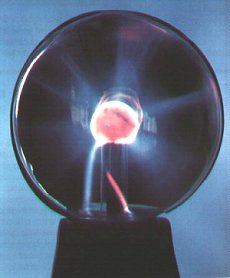The plasma sphere is composed of a spherical glass shell containing a low pressure gas (1-10 mm mercury) and a central electrode. The base where the ball is leaned contains an oscillating circuit that feeds the central electrode with a voltage of about 10 000 Volt and a reversing polarity at about 35 000 Hertz of frequency.
After having connected the device to the electric grid, many "bright filament" form inside the sphere. Some interesting phenomena can be observed, such as: a) the filaments slowly move up; b) approaching a finger to the sphere, the filaments thicken towards it and follow the finger if it moves; c) approaching a low consumption electric bulb to the sphere, you can see its ignition.

|


